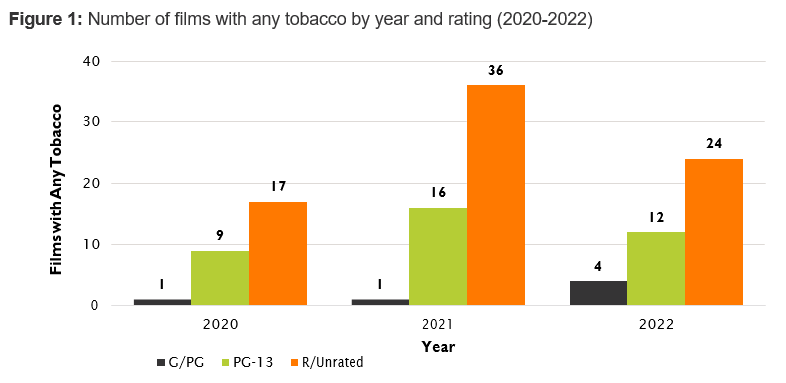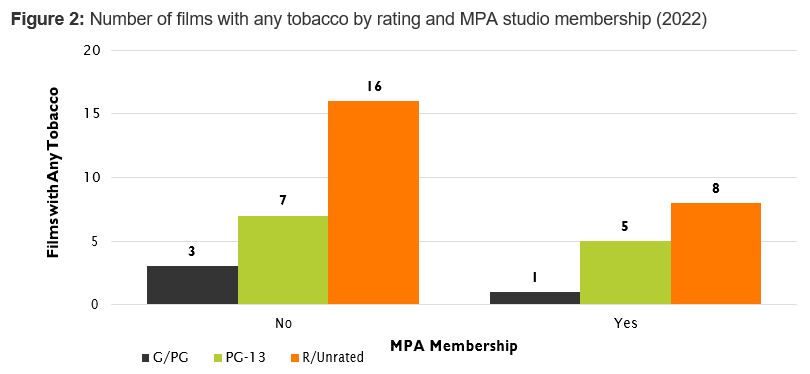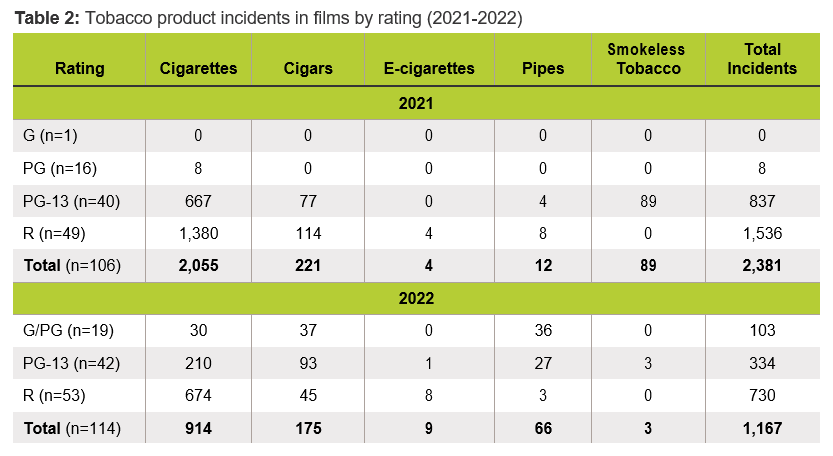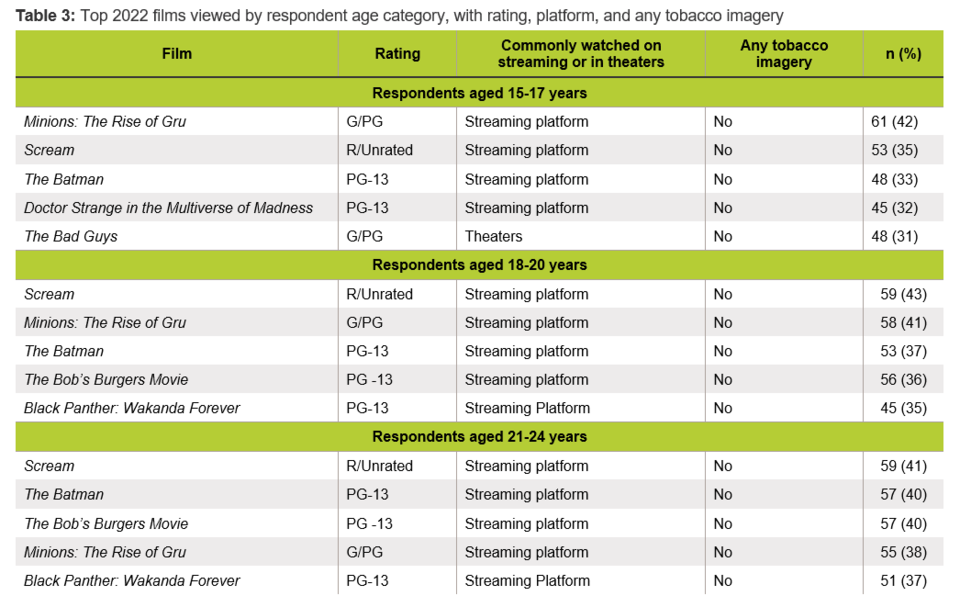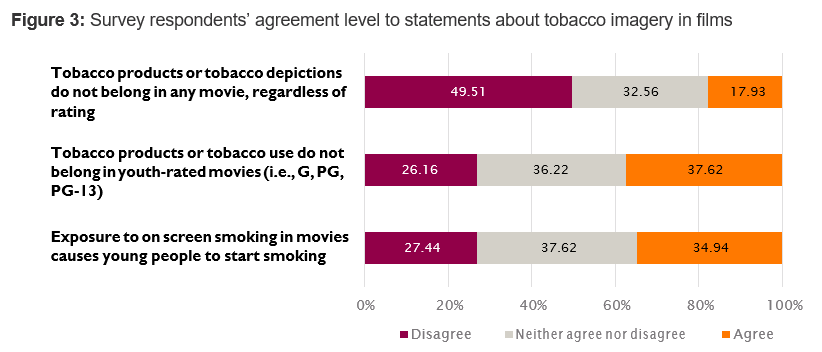Smoking in Films: 2022
This report is by researchers at NORC at the University of Chicago.
In 2003, researchers, state Attorneys General, and policymakers put the Motion Picture Association of America (MPA) on notice of the need to eliminate youth exposure to smoking on screen. However, to date, the film industry has only taken modest steps to reduce or enforce stricter regulations or exclude tobacco imagery in youth-rated (G, PG, PG-13) films. The MPA represents six major film studios in the U.S.: Walt Disney Motion Pictures, Paramount Pictures, Sony Pictures Entertainment, Universal City Studios, Warner Brothers Entertainment, and Netflix. These MPA member studios are committed to lowering tobacco exposure among youth and hold different goals for tobacco-free screens than independent movie studios, who have yet to be as vocal about their commitment to reducing harmful imagery. Non-MPA film studios refer to production companies not part of the MPA. Non-MPA studios can be large studios with publicly traded parent companies or smaller independent studios. Lions Gate Entertainment, STX Films, and BRON Studios are examples of non-MPA member studios, among many others.
Since 2002, the University of California, San Francisco has collaborated with Breathe California and Truth Initiative to analyze onscreen smoking data in the Breathe California Onscreen Tobacco Database and produce annual reports summarizing tobacco presence in top films released that year. In 2021, NORC at the University of Chicago joined the collaborative effort, taking over the analysis and reporting role starting with the 2020 report. Our Tobacco Free Screens Film Viewership Survey supplements the Smoke Free Media Onscreen Tobacco Database, which collects and archives film information, including company and production credits and tobacco product count in films. This 2022 report builds on the 2021 Smoking in Films Report, highlighting findings from both data sources and discussing evolving changes and implications for this research.
Top Films Released in 2022
We identified the top films released in 2022 if they appeared at least once on Box Office Mojo’s Top 10 chart lists. We included 114 films released in 2022 and available to watch in the domestic United States. Table 1 displays the breakdown of 2022 films by rating and MPA member studio production affiliation. Please visit the Smoke Free Media Onscreen Tobacco Database for the film name, release date, company credits, tobacco measures, and additional details on each film.
Technological and social changes in the past few years have drastically changed how films are released and watched. With the proliferation of streaming services that offer movies on demand, more people watch movies at home on their personal televisions or devices compared to those in theaters in the recent past. The COVID-19 pandemic made home viewing even more common. As TV-films increased in popularity, our methodology to collect top films expanded to include additional ratings outside the MPA film ratings. To accurately capture and analyze our data, we grouped films according to the following:
- G/PG rating: Any films rated G, PG, or TV-PG
- PG-13 rating: Any films rated PG-13 or TV-14
- R/Unrated: Any films rated R, TV-MA, Not Rated (NR), or Unrated
Tobacco Imagery in 2022 Films
The total number and percentage of 2022 films with any tobacco was 40 out of 114 films (35%). This percent represents a decline from 2021, where 47% (53 out of 112 films) contained tobacco (Figure 1), representing a 26% decrease in the number of films released with tobacco from 2021 to 2022 (47% in 2021; 39% in 2022).
Overall, smoking and tobacco presence in films is declining. However, a continued portrayal of harmful tobacco imagery in youth-rated films (G, PG, and PG-13) is especially detrimental. In 2022, there were 40 tobacco-containing films, of which 16 (40%) were rated appropriate for youth, one less film than in 2021. Among these youth-rated films with tobacco imagery, an alarming four G/PG-rated films contained tobacco imagery, the most since the 2020 COVID-19 pandemic. Appendix A contains a complete list of 2022 youth-rated films with tobacco. While the number of R-rated films displaying tobacco imagery decreased since 2021 (36 films in 2021; 24 films in 2022), they account for 60% of all films containing tobacco in 2022.
Total number and percentage of films with any tobacco imagery: Studio affiliation
Non-MPA production companies in 2022 accounted for more than half of all films with any smoking or tobacco (Non-MPA studios: 26 films; MPA studios: 14 films) (Figure 2), a trend we first observed in 2019. Non-MPA studios also continue to release more youth-rated films with tobacco imagery than films produced by MPA studios (Non-MPA studios: 10 films; MPA studios: 6 films).
Overall, A24 (4 films), Universal Pictures (4 films), and Paramount (3 films) produced the most number of films with any tobacco. Universal Pictures (4 films), Paramount (3 films), and Sony Pictures (3 films) produced the most number of 2022 films overall with any tobacco among MPA studio members. Among non-MPA studio members, A24 (4 films), Toei Company (2 films), and 2AM (1 film) produced the most number of 2022 films with tobacco.
Total number of tobacco incidents in films
There were 1,167 total tobacco incidents in the top 2022 films, a 50% decrease compared to the 2,315 total tobacco incidents in 2021 films. Tobacco incidents are the number of times tobacco products (e.g., cigarettes, cigars, e-cigarettes, smokeless tobacco, and pipe products) appear in a film. We often divide tobacco incidents by the number of movies each year to determine the average number of tobacco incidents per film and to account for fluctuations in the number of films released annually. In all top 2022 films overall, there was an average of 10 tobacco incidents per film, a decrease of more than half compared to 2021 (21.3 incidents per film).
Tobacco product imagery in films
Tobacco products such as electronic cigarettes (e-cigarettes), cigars, and pipe tobacco continue to make their way into mainstream media in both youth and R-rated films. In 2022, there were 1,167 incidents of tobacco products in 114 rated films. Cigarettes accounted for 914 incidents (78%) and were the most common tobacco product displayed in films (Table 2), despite having a 56% decrease in incidents since 2021. The number of e-cigarette and pipe depictions increased in the top 2022 films compared to the top 2021 films. For the first time, e-cigarettes emerged in a youth-rated movie, the PG- 13-rated film Glass Onion (Netflix; MPA member studio). Redeeming Love, a PG-13 rated film (Talent10; Non-MPA member studio), contained all three incidents of smokeless tobacco. R-rated films continued to include the most number of tobacco incidents. There were no G-rated films that depicted tobacco products.
Audience Exposure to Tobacco Imagery in Top 2022 Films
We calculated an estimate of audience exposure to films with tobacco watched both in theaters and on streaming platforms. Calculating in-theater exposure is based on historical methods dating back to when this work began in 2002. The shift in film-watching and the release of films from in-theater to video-on-demand posed challenges when calculating the number of individuals exposed to tobacco imagery. As a result, researchers from NORC, in collaboration with the Truth Initiative, developed a methodology to estimate tobacco imagery exposure from films watched by youth and young adults on streaming platforms. We used this methodology in our prior reports.
Tobacco Free Screens Film Viewership Survey
NORC, in collaboration with the Truth Initiative, fielded a survey to youth and young adults to measure viewership of top films in 2022 and supplement traditional theater measures using box office estimates. We fielded our survey in April 2023 and asked 1,640 youth and young adults, ages 15-24, to indicate which 2022 films in the Smoke Free Media Onscreen Tobacco Database they watched and whether they first watched the film in theaters or on a streaming service, if at all.
Audience exposure to 2022 films with tobacco: Theater
Before the COVID-19 pandemic in March 2020, the Tobacco in Top Films methodology used total box office revenue and U.S. average ticket sale prices to estimate audience exposure to in-theater tobacco imagery. At the time of writing this report, the 114 top films released in 2022 amassed $7 billion in total domestic box office revenue, with the average ticket price in the United States in 2022 being $9.27. Top in- theater box office films in 2022 exposed an estimated 104,343,823 million youth and adults to tobacco imagery. We calculated this value by using a national average for ticket price and gathered domestic box office revenue data for films containing any tobacco from IMDB Pro (third-party). However, this method only partially accounts for population-level exposure to tobacco in films since the shift of film-watching behaviors, from theaters to streaming, due to the COVID-19 pandemic.

An estimated 21 million youth and young adults are potentially exposed to tobacco imagery in top films watched on streaming platforms in 2022.
Audience exposure to 2022 films with tobacco: Streaming
We estimated potential exposure to tobacco imagery on streaming platforms among youth and young adults based on our calculations of the percentage of survey respondents who viewed at least one film containing tobacco on a streaming platform (53.11%). We scaled this estimate to the U.S. population, using the number of youth and young adults aged 15-24 as part of the 2021 American Community Survey (ACS) five-year estimates (39 million individuals). The resulting figure represents a gross estimate of youth exposed to tobacco on streaming platforms. This method suggests that films on streaming platforms potentially expose an estimated 20,683,491 youth and young adults to tobacco imagery, down from approximately 25 million youth and young adults potentially exposed to tobacco imagery in 2021. Our estimate of tobacco imagery exposure among youth and young adults underestimates the true magnitude of exposure to tobacco imagery through streaming platforms and has several limitations.
Top 2022 films watched by youth and young adults
From a randomized list of 30 top 2022 films, we asked youth and young adults to select the films they watched and where they first watched them (in theaters or on a streaming platform). The films most viewed by youth and young adults overall include Minions: The Rise of Gru (n=174; PG rating; Universal Pictures; MPA member studio), Scream (n=171; R rating; Paramount Pictures; MPA member studio), The Batman (n=158; PG-13 rating; Warner Bros.; MPA member studio), The Bob’s Burgers Movie (n=147; PG-13 rating; Walt Disney Studios; MPA member studio), and Black Panther: Wakanda Forever (n=132, PG-13 rating; Walt Disney Studios; MPA member studio). MPA member studios produced all five films most watched by youth and young adults. Notably, all five top films by youth and young adults did not contain tobacco imagery. Youth and young adults watched these top films on a streaming platform, demonstrating the widespread use of video-on-demand platforms to access and watch newly released films. All top films watched by youth and young adults in our sample did not contain tobacco and were produced by MPA studio members, potentially demonstrating their renewed efforts to remove tobacco from films.
Table 3 displays the top 2022 films by each age group. We observed no variation in the films watched across groups; none contained tobacco imagery. Youth and young adults only watched one film in theaters, The Bad Guys (PG rating; Universal Pictures; MPA member studio). Despite production companies continued concurrent release of films on streaming in theaters, our results demonstrate youth and young adults preferred streaming platforms to access and watch newly released films. This access is especially detrimental given the ease of accessing films that are not age appropriate for youth. For example, as highlighted in our results, the R-rated Scream was a top-watched film via a streaming platform among youth ages 15-17.
Tobacco Use Behaviors & Perceptions
In addition to the viewership and traditional theater measures captured on the survey, NORC, in collaboration with the Truth Initiative, collected respondent-reported data on youth and young adults’ perceptions of smoking and tobacco presence in films.
Perceptions of Tobacco Presence in Films
To better understand how youth and young adults observe and realize the impact of harmful imagery on tobacco use behavior, we showed survey respondents a series of statements about tobacco presence in films and asked them to select their level of agreement. Figure 3 displays results on youth and young adults’ agreement level with statements about tobacco imagery in films and its impact on tobacco youth behavior.
Half of our youth and young adults survey respondents (50%) disagree with the statement that tobacco products or tobacco depictions do not belong in any movie, regardless of rating. Most youth and young adults are ambivalent about whether tobacco products or tobacco use belong in youth-rated films (37% agree; 36% neither agree nor disagree). Further, they are uncertain about the connection between onscreen tobacco exposure and smoking initiation among youth (38%). Together, these results highlight the increased need to inform youth and young adults of the impact between onscreen media exposure and smoking initiation. A publication from Truth Initiative® was the first to find that youth and young adults with high exposure to popular streaming and TV shows containing tobacco images were three times more likely to start vaping than those without exposure.
Future Directions
Our survey data allowed us to identify the top films youth and young adults watched and the medium used to watch them. We also leveraged our survey to calculate a gross estimate of the number of youth and young adults exposed to tobacco imagery in films watched on streaming platforms. Finally, we explored youth and young adults’ perceptions of smoking and tobacco presence in films. Collecting this information better positions our analysis for researchers and public health advocates to speak to the impact of tobacco imagery exposure on youth and young adults’ tobacco use behaviors.
In future reports, we plan on including IMDB rating information to allow us to determine whether audience film rating influences which films youth and adults watch. We also collected data using the Brief Sensation Seeking Scale to explore further youth and young adults’ decision-making in selecting films with tobacco imagery. While we collected information in our survey about the age of tobacco use initiation, we plan on incorporating this in future publications and reports to determine whether consuming media with tobacco influences the age of tobacco use initiation. By collecting this data, we can better position our analysis to speak to the impact of tobacco imagery exposure on youth and young adults’ tobacco use or initiation behavior. Using this survey, we plan on continuously monitoring cross-sectional trends in tobacco imagery exposure and tobacco use over time among youth and young adults.
We are collaborating with Truth Initiative and Breathe California to expand the Smoke Free Media Onscreen Tobacco Database and improve data collection and codebooks. We intend to include additional fields in the database to capture distributor company information to understand which companies are releasing new films on streaming platforms. These database changes ensure we remain abreast of the changing media and tobacco landscape to conduct a more nuanced analysis in future reports.

Methods
This work started in 2002, with methods documented in full in prior reports. Breathe California staff monitor new movie release schedules, Box Office Weekend forecasts, and top 10 movie forecasts weekly. A film is chosen for screening and coding if it appeared at least once on a weekly top 10 list (e.g., Box Office Mojo). Once films are identified and released, one to three Breathe California staff members watch and code the film for the presence of tobacco. Staff members code the amount of tobacco displayed (incidents), tobacco use portrayal, character types using tobacco, and location of tobacco use, among other factors. NORC staff collects information on film production details, including media companies, producers, directors, actors, production budgets, and box office results from publicly available entertainment industry databases and publications (e.g., IMDB and The Numbers). Completed movie records are reviewed and published on the UCSF Smoke Free Media site, with Breathe California staff adjudicating and updating any discrepancies in the records.
NORC at the University of Chicago, in collaboration with the Truth Initiative, fielded a survey in April 2023 to 1,640 youth and young adults (ages 15-24 years) to identify top box office films released in 2022 viewed among this audience. Truth Initiative gathered a representative sample of individuals with a race/ethnicity of 75% White, 13% Black/African American, 6% Asian or Pacific Islander, 6% American Indian Alaskan Native, 50% male, 50% female, 33% of those ages 15-17 years, 33% of those ages 18- 21 years, and 33% of those ages 22-24 years. The survey displayed a randomized block list of 30 films out of the 114 included in the Tobacco Onscreen Database. From the list of 30, respondents selected the films they watched and where they first watched them (in theaters or on a streaming platform, if at all). The survey also asked respondents about their demographics, tobacco use, future use intention, and quitting behaviors.
NORC at the University of Chicago compiled all film records and survey data for 2022 films, analyzed the results, and prepared this report funded by Truth Initiative.
Conclusion
The film industry continues to make marginal progress over the decades toward eliminating the number of films released containing tobacco, as we see a decrease in the number of top films released in 2022 with tobacco presence. However, we continue to see youth-rated films containing tobacco imagery (n=16 films in 2022). Non-MPA member production studios remain the top offender for the most youth- rated films with any tobacco imagery (MPA: 6 films vs. non-MPA: 10 films). Of the 1,167 total incidents of tobacco products in 114 rated films, cigarettes continue to dominate tobacco presence in films, accounting for 914 incidents. An estimated 104 million youth and adults were exposed to tobacco imagery in top films watched in theaters in 2022, while approximately 25 million youth and young adults ages 15-24 were exposed to tobacco imagery viewing movies on streaming platforms. Youth and young adults now use streaming platforms as their primary access to newly released films, as they watched all but one top 2022 film on a streaming platform. Notably, none of the top five films watched by youth and young adults contained tobacco, with MPA members producing all top five films. We will continue to monitor newly released films to track trends and changes in the film-watching behaviors and the film industry that have the potential to impact tobacco use among young people.


